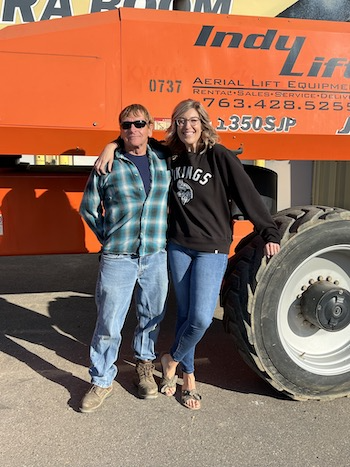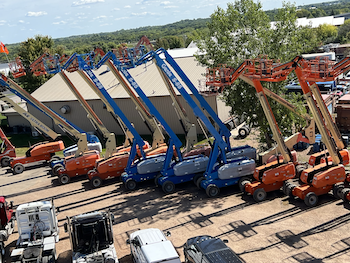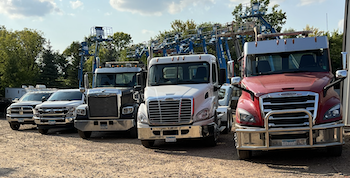Rental Center -- Pulling the pin
Jenny and Tom Indykiewicz decided to liquidate Indy Lift in 2022. Here’s how they did it and why.
by Clair Urbain
 |
|
Jenny and Tom Indykiewicz, retired owners of Indy Lift. |
 |
|
An aerial view of Indy Lift just before the sale. Some equipment was sold before auction; if they had to be on the lot with all of the units going to auction, it would have been difficult to park them all at the St. Michael, Minnesota facility. |
 |
|
Tom Indykiewicz and daughter Chelsey Klasnich, who was outside sales and trainer for Indy Lift the last nine years. |
 |
|
The liquidation sale was September 15 and 16, 2022. |
After 23 years of owning and operating Indy Lift in St. Michael, Minnesota, owner/president Jenny Indykiewicz, and her husband, Tom, operations manager, truck driver and mechanic, decided in July, 2022, it was time to pull the pin.
For readers who don’t have an agricultural background, that’s an end-of-chapter/retirement euphemism. With its roots to unhitching an implement from a tractor, it’s the time when one decides to take a different direction in one’s life. Earlier in a career, it means a change in jobs or vocations; later in life, it means to retire. For the Indykiewiczes, the latter definition applies.
“Tom began his career in 1980 in the lift rental industry, says Jenny. “He’s been with other rental companies and through various promotions to general branch manager, he was one of those affected by a corporate buyout in 1999. Customers began calling me directly to encourage Tom to start his own business,” recalls Jenny.
Until that point, Jenny worked as a human resource professional; but when she and Tom started Indy Lift in 1999, she became president and inside and outside salesperson for the company.
Points of difference
While the company qualifies as a women-owned business, Jenny says the company didn’t directly benefit from that standing. “However, contractors who were working on government jobs could list us as a minority-owned supplier in their contracts,” Jenny explains. When state-run agencies talked with their contractors, they would often recommend Indy Lift as their preferred lift provider.
Indy Lift offered scissor lifts, boom lifts and telehandlers to customers throughout Minnesota. When it was time to liquidate, it had 185 units and a warehouse of parts for sale. “Our success has always been in the fact that we promote and teach safety,” says Tom, “That is what we built our business on over the years.”
While Jenny has been the primary inside salesperson, their daughter, Chelsey Klasnich has been involved with inside and outside sales and lift operator training for the last nine years and enjoyed working in the rental industry. The company had a total of seven employees.
“I think if you work hard at your business, it pays off in the end. It's been a good ride for us. I have no complaints and we love all our customers that supported us for 22 years. I think the hardest part for us was to let them know we were shutting the doors. Some of them came in and told us how much they hated us shutting our doors, but how much they loved us and respected us and that they will miss our service. We were very diligent about our level of service and support tour our customers. I spent a lot of nights and weekends delivering equipment to customers so they could be ready to roll the next morning. That's how we did it,” says Tom.
In addition to servicing its own rental fleet, Indy Lift mechanics provided maintenance, inspection and training services for companies that also owned their own lifts. In the end, that was the catalyst for deciding to liquidate the business over continuing the business or selling out to another entity.
“We are located 34 miles northwest of downtown Minneapolis. There are very few qualified service technicians; they are very hard to find. I know we can train them, but we had such a good reputation. Our technicians were not parts changers. We actually could troubleshoot, diagnose and repair equipment and we didn’t want to stray from that.
“So when the mechanics decided they didn't like one of our other workers, they resigned their positions. We could have made employment adjustments, but decided it was time to retire,” says Jenny. “In this job market, there are so many job offers that you never knew when the day was coming that they were going to leave. Just the bonuses alone companies are using to attract skilled workers are incredible. You just get tired of being held hostage by your employees.”
Decision process
Liquidating the firm was not a spontaneous decision in July, 2022. Instead, the Indy’s had been thinking about exit strategies for several years.
“We worked with an advisory firm on selling our business. We started with them in 2020 when we were very confidentially seeking a buyer for the company. We didn't want it made public because we didn't want to lose employees if they knew we were for sale and we didn't want our major competition to know that we were for sale. While we generated some interest, we weren't willing to stay on long term to run with the company and the investment firms that had any interest wanted us to stay on for two to three, four or five years, and we just weren't willing to do that,” says Jenny.
The Indykiewiczes say the groundwork with their advisor before making the decision to liquidate the business was invaluable. “Just learning about what to expect from investment companies trying to buy your business is helpful,” says Jenny.
“He told us basically how big companies operate,” says Tom. “They want to structure their deal to keep your money for as long as possible. He walked us through all of that. We didn't know about buybacks and all that kind of stuff. We did not know that and that is what we learned from those guys.”
“We learned from an advisor that a deal can look great on paper with the selling price, but when you dive into the details and find you have earn-outs, must leave working capital behind, account for working capital adjustments and write-offs after close of inventory that the buyers write off at your expense, plus the owners must stay on at closing for a term. Those were concerns of ours," Jenny says. “Since we had never sold a business previously, this information was extremely helpful. It clarified our options. Bottom line, you need to look at all the numbers and make a decision that is right for you and your company. We were also concerned that a new company may not take care of business the way we took care of business.”
Auction time
After exploring their options and gauging the used equipment rental market at the time, Jenny and Tom decided that a two-day auction was the best route to take. “We worked with Ritchie Bros. in one of its regional auctions. The equipment stayed in our yard; we did not take it to the auction yard,” says Tom.
Daughter Chelsey sold some equipment out of the fleet before the auction. “We were very comfortable with the auction process because that’s how we mostly acquired and disposed of equipment over the years,” says Jenny. “We had equipment everywhere in the yard; if we hadn’t sold some pieces before the auction, we would have run out of room!” However, 10 days after the auction, the yard was empty. All that remained was a past inventory of lift parts and one telehandler for snow removal.
“We continue to sell off our parts inventory; most of that has been by word of mouth. We are down to the little stuff in comparison to the fleet. It’s amazing how people will pay a good price on a piece of equipment but argue $10 over a little item, like a part,” adds Jenny.
The new reality
They continue to sell off parts inventory and will likely begin posting items online. “In the meantime, Tom now has a 6,900 square-foot man cave that was our shop and office building,” says Jenny. He’s using it to finish working on some hot rods that have been their passion over the years. His separate business, Hot Rods and More, has eight cars in its inventory.
“He has a 36-year Nova project car that he is finally getting time to work on. It’s a nice change from working on all the trucks, trailers and deliveries on top of running the business,” adds Jenny. They own the building and will likely put it up for sale sometime in 2023.
“If you are selling to somebody, you want to really think through to the bottom line. We had some buyers that we didn't think would continue the business like we ran it. We were diligent about our service and trucks and people. We were committed to delivering equipment on time and taking care of our customers. We felt we could have sold the business to someone else, but we wanted to protect our 22-year reputation. We didn't want another company to take our reputation down the toilet,” says Tom.
-end-
This article originally appeared in the March-April 2023 issue of Pro Contractor Rentals magazine. ©Urbain Communications LLC. All rights reserved.








